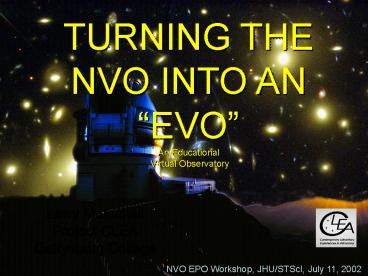HUNTING DOOMSDAY ASTEROIDS - PowerPoint PPT Presentation
1 / 29
Title:
HUNTING DOOMSDAY ASTEROIDS
Description:
NVO EPO Workshop, JHU/STScI, July 11, 2002 ... Also Mike Hayden, Rhonda Good, Mia Luehrmann, Helenmarie Hofmann, Marcus Lieberman, ... – PowerPoint PPT presentation
Number of Views:79
Avg rating:3.0/5.0
Title: HUNTING DOOMSDAY ASTEROIDS
1
TURNING THE NVO INTO AN EVOAn Educational
Virtual Observatory
Larry Marschall Project CLEA Gettysburg College
NVO EPO Workshop, JHU/STScI, July 11, 2002
2
THE TWO PRIME DIRECTIVES IN DEVELOPING
EDUCATIONAL MATERIALS
- Consider your Audience
- Consider your educational objectives
3
AUDIENCES FOR CLASSROOM MATERIALS
- Students Science Majors or Non-Science Majors?
- Faculty Trained Astronomers or Not?
- Institutions HS, 2 yr, 4 yr, Univ?
4
Example Introductory College Level Astronomy
- Who takes introductory astronomy in the US?
- 200 250 K students/year mostly non-science
majors. - Who teaches introductory astronomy in the US?
- Most classes are taught by instructors whose
Ph.D. is NOT in astronomy.
5
EDUCATIONAL CONSIDERATIONS FOR LABORATORY
EXERCISES DIRECTED AT NON-SCIENCE MAJORS
- Keep it simple
- Highlight fundamental astrophysical research
techniques - Avoid black boxiness --- methods should be
transparent to user.
6
EDUCATIONAL CONSIDERATIONS FOR LABORATORY
EXERCISES DIRECTED AT PHYSICS AND ASTRONOMY
MAJORS
- Complexities and tricks can be included
- Clever variations on basic techniques or exotic
applications are acceptable - Avoid black boxiness --- methods should be
transparent to user. - What about teaching data mining itself? Is Data
Mining a black box?
7
An Example PROJECT CLEAContemporary Laboratory
Experiences in Astronomy
- Laboratory exercises illustrating modern
astronomical techniques - Designed for non-science majors, but adaptable.
- Simulation of measurement process.
- Modern digital data and analysis techniques,
using, wherever possible, real data. - Modular each module includes software, student
workbook(s) technical guide. - Funded by Gettysburg College and the NSF
8
PROJECT CLEAContemporary Laboratory Experiences
in Astronomy
Project Staff
- Larry Marschall P.I. Graphic Design and Manuals
- Glenn Snyder Software
- P.Richard Cooper Manager and Outreach
Coordinator - Also Mike Hayden, Rhonda Good, Mia Luehrmann,
Helenmarie Hofmann, Marcus Lieberman, - Students Shawn Baker, Erin Walsh, Brin Finnigan,
Julia Lynch, Lauren Jones, Michell Vojtush
9
PROJECT CLEAContemporary Laboratory Experiences
in AstronomyDISSEMINATION
- Freeware (to educational users).
- Software and manuals downloadable from website
- http//www.gettysburg.edu/academics/physics/clea/
CLEAhome.html - Users in all states and gt 60 countries
- Manuals available in Spanish, Italian, Dutch,
Polish, Hebrew, Kiwi, ???
10
PROJECT CLEAContemporary Laboratory Experiences
in AstronomyTRAINING
- Workshops at AAPT Sectional meetings
- Workshops at AAPT national meetings
- For Physics faculty who are teaching Astronomy
courses 9-day workshops on Research Techniques
in Astronomy, at Gettysburg and Green Bank June
2000, 2001, and coming up 2003 and 2004.
11
PROJECT CLEAContemporary Laboratory Experiences
in AstronomyASSESSMENT
- Pre and post concept tests available for
downloading. - Satisfaction survey available on line.
- Site visits by external evaluator.
- Study of lab and non-lab classes by Gina
Brissenden, University of Wisconsin.
12
EXERCISES FROM PROJECT CLEA (1)
13
EXERCISES FROM PROJECT CLEA (2)
14
EXERCISES FROM PROJECT CLEA (3)
Collaboration over the LAN
15
THE SEARCH FOR OBJECT XA Capstone Exercise
- Students are given the coordinates of an unknown
object and a summary of identification criteria - Access to Optical, Radio, IR and X-ray telescopes
instruments VIREO The Virtual Educational
Observatory - Carry out an observing program of their own
design, identify type of object. - Measure its physical characteristics
- Write report in specified format (Journal
article, lab report, etc). - Note The Object X database currently contains 20
million stars, 50,000 galaxies, 6000 qsos,
20,000 asteroids, 1000 pulsars, 50 million IR
sources. Under development X-ray
16
THE SEARCH FOR OBJECT X and the Virtual
Educational Observatory
17
GENERAL CONSIDERATIONSin making EVOs from the
NVO
- SELECTED DATA SETS, not access to the entire
database, is what is required - THE USER INTERFACE is of prime importance, and
should be designed, if not created, by teachers.
The advice and collaboration of the research
community is essential, however. - BOTH DATA and PROCESSING can be distributed, but
servers may have to handle the onslaught of
classes rather than sporadic users.
18
WHATS NEXT FOR PROJECT CLEA?
- X-Ray Astronomy Integrating CHANDRA data via the
web and DS-9 - OLEO The On-Line Educational Observatory on the
web - I Cant believe its not a real telescope
- Teachers guides and more alternative student
manuals.
19
THENATIONAL VIRTUAL OBSERVATORYis the line
between observation and simulation blurring?
20
CLEA MANUALS IN SPANISH
21
CLEA MANUALS IN ITALIAN
22
CLEA MANUALS IN DUTCH
23
CLEA MANUALS IN HEBREW
24
CLEA MANUALS IN POLISH
25
CLEA MANUALS IN KIWI
26
An older Canned Lab on Spectral Classification
27
Modern Astronomy uses digital spectra displayed
graphically.
28
An Older Canned Lab on Hubbles Law
29
The CLEA WEBSITE http//www.gettysburg.edu/acade
mics/physics/CLEAhome.html































